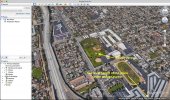I flew a mission earlier this evening with numerous waypoints. I set the altitude to 180 feet for all waypoint and return to home set also at 180 feet to keep everything consistent.
The problem was by time it got to one of the furthest away waypoints it was only circa 50-80 feet above actual ground level. What caused this was the land gradient sloped upwards causing a steady decrease in actual drone height. As the ground level increased the drone did not sense this and adjust its height accordingly.
As far as I am aware you can't tell the slope of the land through a standard top down satellite view so I am relying on the drone to adjust its height so it is always at the height I specify.
So my question is have I missed something and how does the Evo calculate its real-time height - I would have thought it would sense the ground getting higher and adjust its height to compensate but clearly this has not happened.
Any thoughts or advice?
The problem was by time it got to one of the furthest away waypoints it was only circa 50-80 feet above actual ground level. What caused this was the land gradient sloped upwards causing a steady decrease in actual drone height. As the ground level increased the drone did not sense this and adjust its height accordingly.
As far as I am aware you can't tell the slope of the land through a standard top down satellite view so I am relying on the drone to adjust its height so it is always at the height I specify.
So my question is have I missed something and how does the Evo calculate its real-time height - I would have thought it would sense the ground getting higher and adjust its height to compensate but clearly this has not happened.
Any thoughts or advice?





